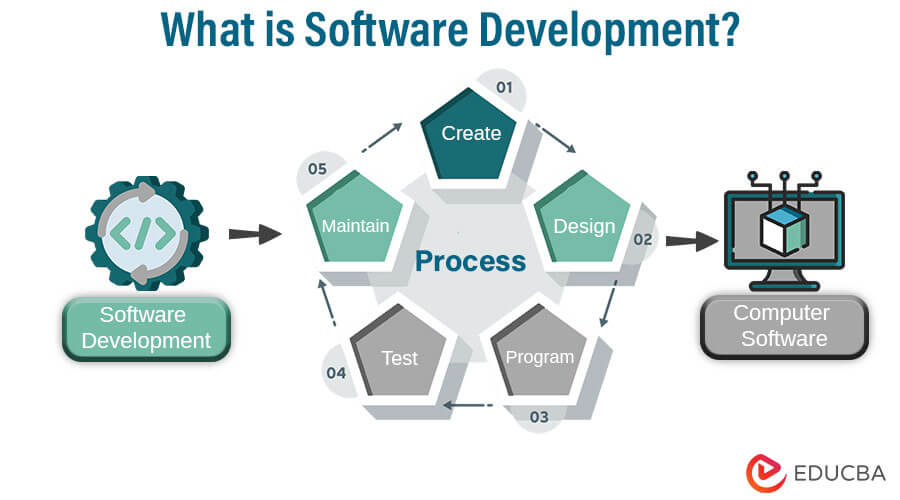Conducting Solutions: Companion with United States for Your Innovative Software Development Demands
Wiki Article
Unlocking Development Possible: Extraordinary Software Growth Methods
In today's busy and highly competitive organization landscape, the capability to innovate is crucial for companies to stay in advance. Unlocking technology potential in software application growth has actually become a pushing obstacle. With the arrival of unprecedented software program development techniques, companies now have accessibility to effective tools and methods that can revolutionize their method to technology. This article discovers the effect of numerous strategies such as Dexterous approaches, Constant Assimilation, Test-Driven Advancement, Devops, and User-Centered Design. By adopting these strategies, companies can streamline their development processes, guarantee software program top quality, bridge the void in between development and procedures, and enhance customer fulfillment. With a thorough expedition of these methods, this post aims to provide important insights for opening technology capacity in the realm of software application growth.Agile Methodologies and Their Impact
Nimble techniques have had a profound effect on software growth practices. With their focus on versatility, cooperation, and repetitive advancement, Agile methodologies have actually transformed the means software program is made, created, and delivered. Conventional software advancement methods, like the Waterfall version, frequently adhered to a consecutive and linear procedure, with minimal room for adaptability and change. Nimble methods have actually brought about a standard change by promoting a more dynamic and customer-centric method.One of the essential benefits of Agile methodologies is the capability to respond rapidly to transforming needs and customer comments. By breaking down intricate jobs right into smaller, workable jobs called sprints, Agile permits growth groups to supply working software program incrementally. This iterative method allows constant screening, assessment, and modification, resulting in greater top quality software application and lowered time-to-market.

In addition, Active approaches focus on customer contentment by entailing stakeholders throughout the growth process - Innovative Software Development. By soliciting constant feedback and integrating it right into the development cycle, Agile ensures that the resulting software program fulfills the progressing needs and assumptions of the end-users
Continuous Assimilation: Streamlining Growth Procedures

CI works by instantly constructing and checking the integrated code, ensuring that it satisfies the quality criteria established by the group (Innovative Software Development). By continually integrating code adjustments, developers can identify and fix bugs or disputes in real-time, reducing the moment and effort needed for troubleshooting later in the advancement cycle. Furthermore, CI enables teams to obtain instant feedback on the influence of their code changes, enabling for faster versions and more efficient collaboration
Carrying out CI needs using specialized tools and facilities to automate the combination and testing processes. These tools can instantly put together code, run tests, and create reports, providing groups with valuable insights into the wellness and stability of their software.
Test-Driven Development: Ensuring Software Program Top Quality
Test-Driven Development plays a vital duty in making sure the quality of software program by assisting programmers to write examinations before applying the equivalent code changes. This approach, also referred to as TDD, follows a rigorous cycle of writing a falling short test, implementing the minimum quantity of code called for to pass the examination, and after that refactoring the code to enhance its layout and maintainability.By composing examinations first, developers have a clear understanding of what the software need to do before they also start coding. This aids them concentrate on meeting the preferred functionality and makes certain that the software application acts as anticipated. Furthermore, TDD provides a safeguard for designers when making adjustments or adding new features. The examinations serve as a form of documents, making it less complicated to recognize the code and determine any unplanned consequences of alterations.
Moreover, TDD urges modular and loosely coupled code, making it much easier to refactor and keep. It also aids catch pests early in the advancement process, lowering the moment and effort invested in debugging and dealing with problems later on.
Devops: Connecting the Void Between Development and Workflow
One key facet of software application advancement that fosters collaboration and enhances performance is the execution of Devops techniques. Devops, a mix of growth and operations, aims to bridge the space in between these two traditionally separate divisions. It focuses on damaging down silos and creating a society of partnership and interaction.Devops practices involve integrating advancement and operations groups to improve the software program advancement lifecycle. This consists of automating processes, such as constant combination and continuous implementation, to ensure faster and extra regular software program launches. By automating repeated jobs, programmers can focus on innovation and delivering worth to clients.
Moreover, Devops encourages the use of dexterous approaches, such as Scrum or Kanban, to allow step-by-step and iterative growth. This enables faster feedback loops and faster time-to-market.
In addition to fostering collaboration, Devops likewise stresses the importance of tracking and feedback. By executing tracking devices and techniques, development and operations teams can recognize and address problems in real-time, guaranteeing the security and performance of the software.
User-Centered Layout: Enhancing Client Complete Satisfaction
User-centered design plays an essential function in enhancing customer satisfaction by prioritizing their requirements and choices throughout the software program development process. Considering the end individuals' requirements and expectations helps in developing software application that is instinctive, easy to use, and meets their particular demands. By adopting link a user-centered layout approach, software growth groups can make certain that the end product aligns with the customers' goals and supplies a pleasurable and seamless experience.One key facet of user-centered layout is carrying out comprehensive user research study. This information is after that utilized to educate the design and advancement decisions, ensuring that the software satisfies the users' expectations.
This involves observing and accumulating comments from individuals as they interact with the software program. By examining the software with real users, programmers can recognize any functionality concerns, discomfort factors, or areas of renovation.
Final Thought
To conclude, making use of nimble approaches, continuous combination, test-driven development, DevOps, and user-centered style have actually changed software development methods. These techniques have actually made it possible for link software program groups to simplify growth procedures, ensure software program high quality, bridge the gap in between development and procedures, and enhance client satisfaction. By adopting these innovative strategies, companies can unlock their full development potential and remain in advance in today's competitive market.By embracing these techniques, companies can streamline their development processes, guarantee software top quality, bridge the void between advancement and procedures, and boost customer complete satisfaction.With the shift in the direction of even more vibrant and customer-centric software program development techniques, continuous assimilation has emerged as an essential procedure for simplifying growth and improving cooperation within groups.Devops methods include incorporating growth and operations groups to simplify the software program development lifecycle.In final thought, the usage of dexterous methods, continuous assimilation, test-driven growth, DevOps, and user-centered style have actually revolutionized software application growth techniques. These techniques have made it possible for software teams to streamline advancement procedures, make sure software quality, bridge the void between advancement and operations, great site and improve client complete satisfaction.
Report this wiki page